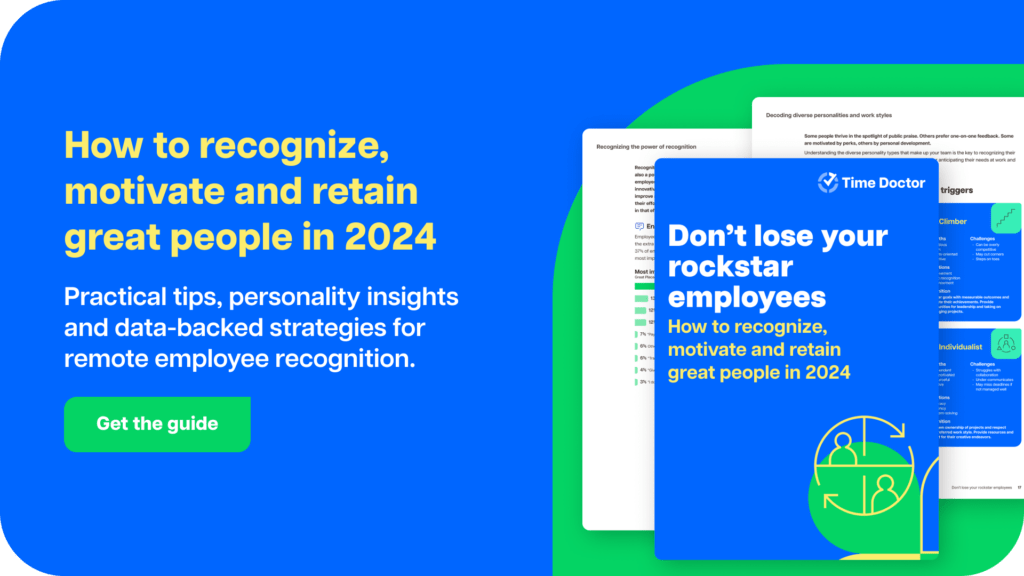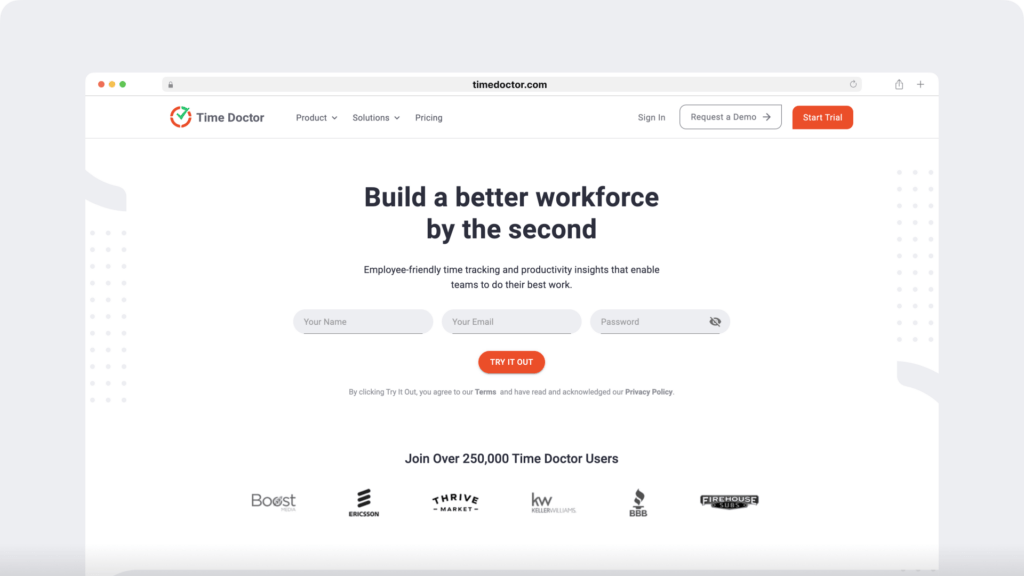When employees feel valued and recognized as individuals, they act in ways that benefit colleagues, managers and the organization. They’re also happier, healthier and more engaged.
Gallup and Workhuman studied thousands of employees across several countries to gauge the power of recognition. They found that when recognition efforts resonate, employees are:
- 73% less likely to experience burnout
- 56% less likely to be looking for another job
- 5x as likely to feel connected to their culture
- 44% more likely to be “thriving” in their life
In short, recognition is a powerful motivator and antidote to employee burnout.
So, it’s worrying that the same study found that 81% of leaders don’t make recognition a strategic priority.
This isn’t a one-off result.
According to Gallup’s latest employee engagement data, just 30% of US employees say they receive recognition every week.
That’s three percentage points lower than at the height of the pandemic. It also tracks with employee engagement, overall satisfaction at work, connection to purpose, commitment to quality and several other indicators, which all dipped since 2020.
It’s no wonder that eight in 10 employees (82%) regularly experience burnout symptoms. Recognition affects an employee’s sense of purpose, which significantly impacts their well-being at work.
To mitigate the very real risks of employee burnout, recognition must become a strategic priority. Putting recognition on everyone’s radar – including frontline employees, team leaders and organizational managers – begins with understanding that new ways of working are challenging old-school recognition strategies.
Table of Contents
The challenges of recognizing remote employees
The accelerated transition to remote and hybrid work has brought many benefits for employees and companies. However, the same flexibility that attracts employees can make it difficult for managers to notice and acknowledge their achievements.
Without in-person interactions, employees can feel disconnected from culture, colleagues, and supervisors. Unfortunately, this feeling is often valid. One of the most commonly cited challenges of managing remote employees is a lack of visibility over what they do.
Communication barriers amplify disconnection. The days of spontaneous conversations, hallway congratulations, or overhearing praise in an open office are gone. Translating these efforts to virtual channels can help, though there is a risk that recognition comes across as ingenuine.
All these factors mean that not only the quiet achievers but also the extroverts risk becoming invisible.
Without intentional and sustained action on employee recognition, organizations will lose the people they need to build resilience for the future.
Amid a global talent shortage, we must ensure good people are cared for. Learn how to retain rockstar employees and build a future-ready workforce with our latest free guide.

What recognition looks like in hybrid and remote workforces
Around two-thirds of managers (61%) and top-level leaders (67%) say they dole out recognition at least weekly. This seems at odds with the rate at which employees say they receive positive feedback.
There’s a good reason.
It’s possible that the employee doesn’t recognize they’re receiving recognition. This isn’t the manager’s fault, but it is their responsibility, at least partly.
Traditional recognition strategies don’t work in remote offices*. Team leaders must find new ways to show their appreciation, and they must do it often.
Think about more than money
While financial rewards have their place, and everyone should be paid fairly, recognition encompasses much more than money.
Several recent studies (and many older ones) suggest that meaningful symbolic gestures are more effective motivators than monetary incentives.
This comes back to the core purpose of employee recognition.
People want to feel connected to work that has value. So, for remote employees who may feel disconnected from company culture, gestures that address their need for belonging and achievement can be significantly more motivating.
Physical to virtual: *Some recognition strategies do work remotely
Some traditional recognition methods can be adapted for remote teams.
For example, the equivalent of bringing donuts to the office could be sending gift cards for coffee or lunch to remote employees after a successful project.
Similarly, public recognition can be adapted to virtual environments through shout-outs in video meetings or recognition posts on company-wide platforms. A manager could send a personalized email thanking an employee instead of leaving a note on their desk.
Transitioning from physical to virtual recognition is far from impossible. It merely requires creativity.
Peer-to-peer recognition is a ‘rising tide’ for remote teams
Recognition from colleagues not only fosters a positive work environment but also helps to build strong connections that are crucial for remote teams.
By facilitating a culture where everyone can nominate and celebrate each other’s achievements, you create a more cohesive and supportive remote workforce.
Peer-to-peer employee recognition can be spontaneous and simple. A shout-out on Slack or a quick email thanking the team for their efforts on a project.
You might also consider investing in a formalized peer recognition program to ingrain it in the company’s culture.
For example, the German utility company E.On encourages employees to send thank-you notes through the Buzz employee engagement program. This low-cost, low-effort employee recognition initiative resulted in 13% more employees feeling valued, an 18% better understanding of the company’s vision, and 8% higher engagement.
New solutions for distributed teams
In the old world of work, monetary incentives, public shout-outs and free lunches were widely accepted as the way to recognize good work.
As you can see from the three tenets of remote employee recognition above – more than money, remote-friendly, and peer-to-peer – new work models require new recognition strategies.
Here are a few ideas to get you started.
Encourage giving
- Implement platforms allowing digital shout-outs, badges, or points for colleagues
- Create a communication channel dedicated to acknowledging peer achievements
- Set up a virtual “kudos” board for posting gratitude messages and acknowledgments
- Encourage employee participation in nominating peers for awards or recognition programs
Provide growth opportunities
- Offer access to online courses or certifications to recognize an employee’s unique skills
- Create a mentorship program to help ambitious employees develop new skills or advance their careers
- Sponsor attendance at virtual conferences or workshops
Appreciate informally
- Offer off-the-cuff praise in online meetings or during video conferences
- Send quick emails or messages highlighting specific contributions
- Use features on video conferencing platforms for quick, informal recognition
Organize digital activities
- Host virtual team-building events, like online games or trivia quizzes
- Arrange virtual coffee breaks or lunch hours to foster casual interactions
- Host a hackathon to encourage creative problem-solving and innovation
Make a personal connection
- Reach out personally with a message, phone call or thank-you note
- Schedule virtual coffee chats with remote employees to get to know them better
- Coordinate a team lunch (e.g. with a food delivery service) to encourage casual conversation and connection
Publicize accomplishments
- Highlight employee achievements in the company newsletter or intranet
- Share employee success stories on the company’s social media platforms
- Create a “Wall of Fame” on your company’s digital workspace
Give them time
- Offer additional paid time off or mental health days to prevent burnout
- Offer flexible work arrangements to build trust and empower remote employees with control over their schedules
- Encourage employees to utilize paid time off and discourage checking emails or attending meetings while on vacation
- Establish “no meeting” days or times when employees can focus without interruptions, acknowledging their need for dedicated work time
Recognition takes many forms
You might be looking at these ideas and thinking some aren’t recognizable as recognition.
“Recognition” and “reward” are different. Recognition is about acknowledging your team’s contributions through personal, specific and frequent feedback, while a reward is a one-time perk for going the extra mile.
Recognition reinforces belonging – the connection to culture that every human needs. Rewards reinforce exceptional effort, which gives a nice feeling but doesn’t do much for sustained motivation.
Occasionally, recognition comes in the form of rewards. However, really effective recognition strategies are ingrained in a culture where people feel valued and appreciated.
Read more: Creating a culture of recognition to boost employee engagement.
Tips for effective employee recognition in remote and hybrid offices
As an organizational leader facing a global skills shortage and evolving employee preferences, meaningful recognition is one of the most effective tools for motivating and retaining great people.
Be authentic
A genuine shout-out is more impactful than a perfunctory gold star. Focus on aspects of an employee’s performance that have made a genuine and measurable difference.
Workforce analytics helps here. By providing real-time data and long-term productivity trends, workforce analytics removes biases (like personality and proximity) to show you how people really work.
Get specific
Gallup’s research found that 72% of employees with great recognition experiences say their leaders recognize the “little things.” Tie recognition to a specific accomplishment to show you see individual contributions, not just generic performance.
Time it right
The sooner and more frequently you recognize an achievement, the more impactful it will be. Encourage colleagues to demonstrate recognition every day or every week and develop a formal system to reduce lag time.
Make it personal
Positive feedback from key stakeholders can be particularly motivating for social (a.k.a. extroverted) employees. Consider whose recognition means the most to an employee: their supervisor, an executive, or a colleague.
Go public
Private feedback is appropriate sometimes, but public recognition can motivate the entire team. It can feel more impactful for the recipient and boost overall morale. However, it’s worth considering the negative signals that public praise can send and adapting your message to avoid favoritism or tokenism.
Details matter
Employees can tell the difference between a rushed gesture and genuine appreciation. For example, a handwritten thank-you note signed by a manager and mailed home is more meaningful than a generic email.
Start small
Recognition doesn’t need to be expensive or extravagant to counteract employee burnout and motivate remote employees. Simple gestures like notes from a colleague or a quick shout-out in a meeting can be effective (and cost-efficient) ways to show appreciation.
We recognize the challenges of managing remote employees
Building a culture of recognition is essential for a thriving remote workforce. However, it can be challenging to track individual contributions, find the right way to acknowledge them, and prevent employee burnout.
Time Doctor’s industry-leading workforce analytics tools help you solve all three problems simultaneously.
Track employee contributions
Real-time tracking and detailed reporting give team leaders a clear, objective view of each team member’s contributions and work patterns.
This data-driven insight allows for recognizing the quantity, quality and efficiency of work being done.
You can see which team members regularly go the extra mile, solve problems efficiently or demonstrate exceptional teamwork, simply by analyzing the workforce data at your fingertips.
Level the playing field
When employees know their contributions are seen and measured accurately alongside their peers, it fosters a culture of collaboration rather than individualism. As a bonus, company-wide workforce analytics also minimizes the risk of recognition being misinterpreted as favoritism.
Clear activity tracking also fosters accountability and ownership among employees. This transparency is crucial in those scenarios where “recognition” means recognizing an employee’s need for autonomy and flexibility.
Balance effort and wellbeing
By monitoring productivity and engagement signals, you can see whether your efforts to motivate your team are having the desired impact. And by monitoring work-life balance signals, you can trust that those efforts aren’t compromising employee wellbeing.
Time Doctor’s work-life balance tools allow you to track metrics like overtime, long days and weekend work to intervene before employee burnout becomes an issue.
These features address a challenge with managing remote employees that tends to go unrecognized: visibility.
Time Doctor helps you foster a culture of recognition

Employee recognition is a highly potent and underutilized strategy for motivating and energizing the workforce of the future.
Companies that get employee recognition right will enjoy the benefits of an engaged, motivated, collaborative and loyal workforce. Companies that miss the mark will see employee burnout rise and good people walk.
But there’s a catch. Traditional recognition strategies don’t always translate to virtual environments. For anyone managing remote employees, that means rethinking recognition to develop individually tailored strategies.
Here at Time Doctor, we’re no strangers to the new strategies needed to manage remote employees, including recognition. If you’re a leader in a transitioning organization, we’ll help you reframe recognition to boost motivation and fight employee burnout.
How? Through workforce analytics.
Reliable workday data is your window into recognizing hard work, assessing employees’ needs, and measuring the output of motivational strategies. Get started today with a free trial or view a demo to see Time Doctor’s features in action and get personalized tips for using workplace analytics to enhance employee recognition.

Carlo Borja is the Content Marketing Manager of Time Doctor, a workforce analytics software for distributed teams. He is a remote work advocate, a father and a coffee junkie.


